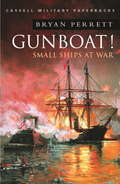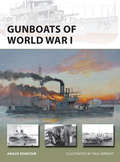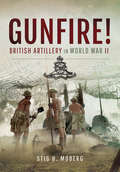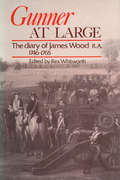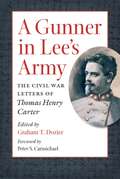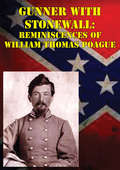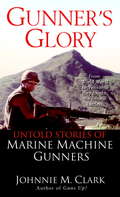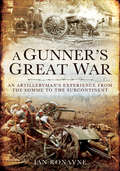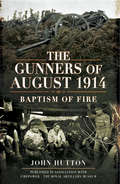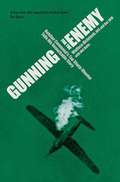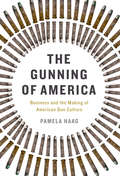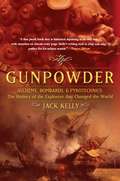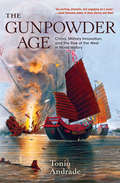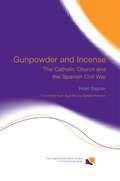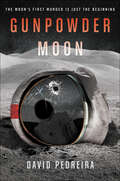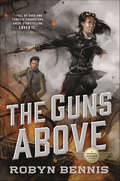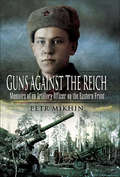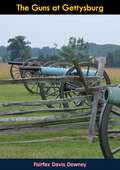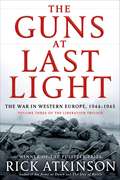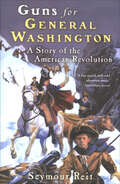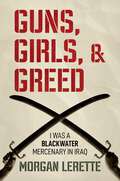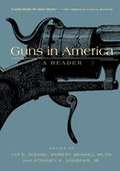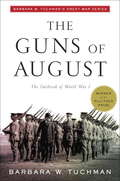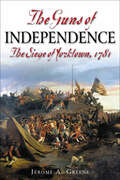- Table View
- List View
Gunboat!: Small Ships At War
by Bryan PerrettThis is naval action adventure with a difference - thirteen naval engagements in which gunboats won the day against every kind of enemy, large and smallBritain, like other colonial powers, established, controlled and accessed her empire from the seas. It was realised that the preservation of secure trading conditions required armed ships able to operate in shallow coastal and river waters. The gunboat was developed to meet this need: a small, shallow-draft, steam-powered screw or paddle driven vessel, sufficiently fast and manoeuvrable to take the enemy, whether on shore or afloat, by surprise.In this book Bryan Perrett recounts thirteen episodes of exciting gunboat action, ranging from the Burma war in 1824, through two world wars and on to the dramatic escape of the Amethyst down the Yangtze in 1949.
Gunboats of World War I
by Angus KonstamFrom the Mediterranean to the Black Sea, from the Balkans to Mesopotamia, gunboats played an influential part in the story of World War I. This detailed technical guide to the gunboats of all the major navies of the war means that, for the first time, the story can be told. Naval action in World War I conjures up images of enormous dreadnoughts slugging it out in vast oceans. Yet the truth is that more sailors were killed serving on gunboats and monitors operating far from the naval epicentre of the war than were ever killed at Jutland. Gunboat engagements during this war were bloody and hard fought, if small in scale. Austrian gunboats on the Danube fired the first shots of the war, whilst German, British and Belgian gunboats fought one of the strangest, most intriguing naval campaigns in history in far-flung Lake Tanganyika.
Gunfire!: British Artillery in World War II
by Stig H. MobergThis book provides an insight into how artillery resources were established, developed and employed during the Second World War, using the British Royal Artillery as an example. Beginning with an overview of the nature and state of readiness of the Royal Artillery on the outbreak of war, the book analyses in great detail the weapons available to the Royal Artillery, their technical functionality and their performance capabilities. With this knowledge the author then examines the organization, methods, procedures and tactics employed by the Royal Artillery. To complete this fascinating study, Stig Moberg looks at a number of key battles from the war to see how the artillery was used, and the effectiveness of its support to the British and Allied infantry, in campaigns in North Africa, Burma and Europe. British Artillery of the Second World War is profusely illustrated throughout with photographs, maps, plans, graphs, charts and diagrams to demonstrate precisely how the British Artillery was used on the battlefields around the world. Although I am an infantryman, and proud of it, I have many times said that the Royal Regiment of Artillery, in my opinion, did more to win the last war, more than any other Arm of the Service.Field Marshal Bernard Montgomery
Gunner at Large: The Diary of James Wood R.A. 1746-1765
by Rex WhitworthJames Wood was one of the first trained at Woolwich and served successively as a Volunteer, Mattross, Cadet, Cadet Gunner and Fireworker in France, the Low Countries, Scotland and India.
A Gunner in Lee's Army
by Peter S. Carmichael Graham DozierIn May 1861, Virginian Thomas Henry Carter (1831-1908) raised an artillery battery and joined the Confederate army. Over the next four years, he rose steadily in rank from captain to colonel, placing him among the senior artillerists in Robert E. Lee's Army of Northern Virginia. During the war, Carter wrote more than 100 revealing letters to his wife, Susan, about his service. His interactions with prominent officers--including Lee, Jubal A. Early, John B. Gordon, Robert E. Rodes, and others--come to life in Carter's astute comments about their conduct and personalities. Combining insightful observations on military operations, particularly of the Battles of Antietam and Spotsylvania Court House and the 1864 Shenandoah Valley Campaign, with revealing notes on the home front and the debate over the impressment and arming of slaves, Carter's letters are particularly interesting because his writing is not overly burdened by the rhetoric of the southern ruling class.Here, Graham Dozier offers the definitive edition of Carter's letters, meticulously transcribed and carefully annotated. This impressive collection provides a wealth of Carter's unvarnished opinions of the people and events that shaped his wartime experience, shedding new light on Lee's army and Confederate life in Virginia.
Gunner with Stonewall: Reminiscences Of William Thomas Poague [Illustrated Edition]
by Bell Irvin Wiley Monroe F. Cockrell Lt.-Col. William Thomas PaogueIncludes Civil War Map and Illustrations Pack - 224 battle plans, campaign maps and detailed analyses of actions spanning the entire period of hostilities.An excellent memoir from one of Stonewall Jackson's artillery officers who fought throughout the Civil War until final defeat.Born in Rockbridge County, Virginia in 1835, the opening of the Civil War found William T. Poague practicing law in Missouri. As the first shots began flying he repaired to his home state to offer his services to the Confederate army. He started his army life as a second lieutenant in the famous Rockbridge Virginia Artillery and would fight with gallantry, courage and great skill on many Civil War battlefields. He was engaged at First Manassas, Romney, Kernstown, the Seven Days Campaign, Cedar Mountain, Second Manassas, Harper's Ferry Antietam, and Fredericksberg. By this time his distinguished conduct had led him to be promoted to Major and fought on at Chancellorsville, Gettysburg, the Wilderness, Cold Harbor before the final surrender at Appomattox.This edition was edited by noted Civil War historian Monroe F. Cockerell and has an excellent introduction by Bell Irwin Wiley.
Gunner's Glory: Untold Stories of Marine Machine Gunners
by Johnnie ClarkThey were warriors, trained to fight, dedicated to their country, and determined to win. At Guadalcanal, the Marine Corps' machine gunners took everything the Japanese could throw at them in one of the bloodiest battles of World War II; their position was so hopeless that at one point they were given the go-ahead to surrender. Near the Chosin Reservoir in Korea, as the mercury dropped to twenty below, the 1st Marine Division found itself surrounded and cut off by the enemy. The outlook seemed so bleak that many in Washington had privately written off the men. But surrender is not part of a Marine's vocabulary. Gunner's Glorycontains true stories of these and other tough battles in the Pacific, in Korea, and in Vietnam, recounted by the machine gunners who fought them. Bloody, wounded, sometimes barely alive, they stayed with their guns, delivering a stream of firepower that often turned defeat into victory-andalwaysmade them the enemy's first target. From the Paperback edition.
A Gunner's Great War: An Artilleryman's Experience from the Somme to the Subcontinent
by Ian RonayneIf the First World War had not happened when it did, Channel Islander Clarence Ahier would almost certainly have led a mostly unremarkable life. But it did, and in October 1915, aged just 23-years-old, Clarence left his home and volunteered to join the British Army. He would spend the next two and half years serving as an artillery man on the Western Front.Now this in itself is not remarkable—millions of other young men did the same thing. But Clarence Ahier did do something remarkable, and it was something to set him out from almost all his contemporaries. From the very beginning of his time at the front, he wrote a graphic and moving account of his experiences of war.Clarences ultimate plans for his meticulously written journal are unknown. But having lain unnoticed for years, it was recently discovered in a collection of dusty ephemera handed to a local history society.The complete journal consists of around 25,000 words, with a focus on Clarences experience during the Battle of the Somme, in the fighting around Ypres, and, after he was wounded for the second time, the journey to India and his time there as a member of the garrison. This will be supported by additional explanatory text.
The Gunners of August 1914: Baptism of Fire
by John HuttonThe Great War will always be synonymous with trench warfare and the mass slaughter inflicted by machine guns on the helpless but gallant infantry. There is a good reason for this view as the machine guns took a terrible toll, and the infantry's experiences continue to fascinate and appal people today. But one aspect of the fighting that gets insufficient attention is the artillery. Histories of the major battles often reduce the role of the big guns to a few paragraphs, and this has created a seriously distorted impression of the reality of the fighting. A better balance needs to be struck, and that is the intention of John Hutton's new book on the gunners of 1914.He tells the story of the war as the gunners themselves saw it, focusing on the first few months of warfare which were fundamental to the conduct of the campaign. The gunners may not have always shared the trench experiences of the infantry in the front line, but they were in the thick of the action, and success or failure depended on them. The personal testimonies of those who served with and supported the guns provide a vital insight into the colossal tragedy and drama of the war from the artilleryman's point of view.
Gunning for the Enemy: Bomber Command's Top Sharp-Shooter Tells His Remarkable Story
by Wallace McIntosh Mel RolfeThe World War II exploits of the legendary RAF air gunner, &“a true hero who repeatedly cheated death,&” from the author of Flying into Hell (The Times). Born into grinding poverty in Scotland, Wallace McIntosh had not heard of Christmas until he was seven, and never celebrated his birthday until his late teens, but he could steal, kill and skin a sheep before he was twelve and snare anything that could be cooked in a pot. Leaving school at thirteen he was determined to escape the constant struggle to survive. Gunning for the Enemy tells the moving story of how the RAF finally accepted McIntosh after at first rejecting him, but then initially gave him the lowliest of jobs. Only by a fluke was he trained as an air gunner. During his time with 207 Squadron, based at Langar, Nottinghamshire and Spilsby, Lincolnshire, he flew over fifty sorties in World War Two. Although Bomber Command did not record details of &“kills&” by air gunners, Wallace, who shot down eight enemy aircraft with one probable, is widely believed to be its top sharpshooter and at one time he was its most decorated also. He had many hairy incidents and his prodigious memory for detail enables him to recall numerous amazing escapes from death and how each and every night he and his comrades dramatically took the war to the enemy. This is a story of outstanding courage, told with wit, pace and honesty by Mel Rolfe who has previously enjoyed acclaim with such books as To Hell and Back, Hell on Earth and Flying into Hell.
The Gunning of America: Business and the Making of American Gun Culture
by Pamela HaagAmericans have always loved guns. This special bond was forged during the American Revolution and sanctified by the Second Amendment. It is because of this exceptional relationship that American civilians are more heavily armed than the citizens of any other nation.Or so we're told.In The Gunning of America, historian Pamela Haag overturns this conventional wisdom. American gun culture, she argues, developed not because the gun was exceptional, but precisely because it was not: guns proliferated in America because throughout most of the nation's history, they were perceived as an unexceptional commodity, no different than buttons or typewriters.Focusing on the history of the Winchester Repeating Arms Company, one of the most iconic arms manufacturers in America, Haag challenges many basic assumptions of how and when America became a gun culture. Under the leadership of Oliver Winchester and his heirs, the company used aggressive, sometimes ingenious sales and marketing techniques to create new markets for their product. Guns have never "sold themselves"; rather, through advertising and innovative distribution campaigns, the gun industry did. Through the meticulous examination of gun industry archives, Haag challenges the myth of a primal bond between Americans and their firearms. Over the course of its 150 year history, the Winchester Repeating Arms Company sold over 8 million guns. But Oliver Winchester-a shirtmaker in his previous career-had no apparent qualms about a life spent arming America. His daughter-in-law Sarah Winchester was a different story. Legend holds that Sarah was haunted by what she considered a vast blood fortune, and became convinced that the ghosts of rifle victims were haunting her. She channeled much of her inheritance, and her conflicted conscience, into a monstrous estate now known as the Winchester Mystery House, where she sought refuge from this ever-expanding army of phantoms.In this provocative and deeply-researched work of narrative history, Haag fundamentally revises the history of arms in America, and in so doing explodes the clichés that have created and sustained our lethal gun culture.
Gunpowder: The History of the Explosive that Changed the World
by Jack KellyWhen Chinese alchemists fashioned the first manmade explosion sometime during the tenth century, no one could have foreseen its full revolutionary potential. Invented to frighten evil spirits rather than fuel guns or bombs--neither of which had been thought of yet--their simple mixture of saltpeter, sulfur, and charcoal went on to make the modern world possible. As word of its explosive properties spread from Asia to Europe, from pyrotechnics to battleships, it paved the way for Western exploration, hastened the end of feudalism and the rise of the nation state, and greased the wheels of the Industrial Revolution. With dramatic immediacy, novelist and journalist Jack Kelly conveys both the distant time in which the "devil’s distillate” rose to conquer the world, and brings to rousing life the eclectic cast of characters who played a role in its epic story, including Michelangelo, Edward III, Vasco da Gama, Cortés, Guy Fawkes, Alfred Nobel, and E. I. DuPont. A must-read for history fans and military buffs alike, Gunpowder brings together a rich terrain of cultures and technological innovations with authoritative research and swashbuckling style.
The Gunpowder Age: China, Military Innovation, and the Rise of the West in World History
by Tonio AndradeThe Chinese invented gunpowder and began exploring its military uses as early as the 900s, four centuries before the technology passed to the West. But by the early 1800s, China had fallen so far behind the West in gunpowder warfare that it was easily defeated by Britain in the Opium War of 1839-42. What happened? In The Gunpowder Age, Tonio Andrade offers a compelling new answer, opening a fresh perspective on a key question of world history: why did the countries of western Europe surge to global importance starting in the 1500s while China slipped behind?Historians have long argued that gunpowder weapons helped Europeans establish global hegemony. Yet the inhabitants of what is today China not only invented guns and bombs but also, as Andrade shows, continued to innovate in gunpowder technology through the early 1700s--much longer than previously thought. Why, then, did China become so vulnerable? Andrade argues that one significant reason is that it was out of practice fighting wars, having enjoyed nearly a century of relative peace, since 1760. Indeed, he demonstrates that China--like Europe--was a powerful military innovator, particularly during times of great warfare, such as the violent century starting after the Opium War, when the Chinese once again quickly modernized their forces. Today, China is simply returning to its old position as one of the world's great military powers.By showing that China's military dynamism was deeper, longer lasting, and more quickly recovered than previously understood, The Gunpowder Age challenges long-standing explanations of the so-called Great Divergence between the West and Asia.
Gunpowder and Incense: The Catholic Church and the Spanish Civil War (Routledge/Canada Blanch Studies on Contemporary Spain)
by Hilari RaguerNow available in English for the first time, Gunpowder and Incense (translated from the Spanish La Pólvora y el Incienso) chronicles the role of the Church in Spanish politics, looking in particular at the Spanish Civil War. Unlike most books on the subject, Hilari Raguer looks beyond the traditional explanation that the war was primarily a religious struggle. His writing presents an exemplary "insider's" perspective, and is notable for its balance and perception on the role of the Catholic Church before, during and after the War. The material is presented in a lucid, elegant manner - which makes this book as readable as it is historiographically important. It will be vital reading for students and scholars of European, religious and modern history.
Gunpowder Moon
by David PedreiraAn Amazon Best Books of the Year selectionBookBub Breakout Debut Novels of Winter 2018The Verge―18 Science Fiction and Fantasy Books to Read in FebruaryBarnes & Noble—One of 25 Sci-Fi/Fantasy Debuts to Watch for in 2018Nerdmuch—Best New Sci-Fi & Fantasy Books of 2018Bookish—Winter 2018’s Hottest Sci-Fi and Fantasy BooksLibrary Journal: Spring/Summer Best Debut Novels“Interesting quirks and divided loyalties flesh out this first novel in which sf and mystery intersect in a well-crafted plot...Pedreira’s science thriller powerfully highlights the human politics and economics from the seemingly desolate expanse of the moon. It will attract readers who enjoyed Andy Weir’s lunar crime caper Artemis.” -- Library Journal, starred reviewA realistic and chilling vision of life on the Moon, where dust kills as easily as the vacuum of space…but murder is even quicker—a fast-paced, cinematic science fiction thriller, this debut novel combines the inventiveness of The Martian, the intrigue of The Expanse, and the thrills of Red Rising.The Moon smells like gunpowder. Every lunar walker since Apollo 11 has noticed it: a burnt-metal scent that reminds them of war. Caden Dechert, the chief of the U.S. mining operation on the edge of the Sea of Serenity, thinks the smell is just a trick of the mind—a reminder of his harrowing days as a Marine in the war-torn Middle East back on Earth.It’s 2072, and lunar helium-3 mining is powering the fusion reactors that are bringing Earth back from environmental disaster. But competing for the richest prize in the history of the world has destroyed the oldest rule in space: Safety for All. When a bomb kills one of Dechert’s diggers on Mare Serenitatis, the haunted veteran goes on the hunt to expose the culprit before more blood is spilled.But as Dechert races to solve the first murder in the history of the Moon, he gets caught in the crosshairs of two global powers spoiling for a fight. Reluctant to be the match that lights this powder-keg, Dechert knows his life and those of his crew are meaningless to the politicians. Even worse, he knows the killer is still out there, hunting.In his desperate attempts to save his crew and prevent the catastrophe he sees coming, the former Marine uncovers a dangerous conspiracy that, with one spark, can ignite a full lunar war, wipe out his team . . . and perhaps plunge the Earth back into darkness.
The Guns Above: A Signal Airship Novel (The Signal Airship Novels #1)
by Robyn BennisRobyn Bennis’s THE GUNS ABOVE is an adventurous military fantasy debut about a nation's first female airship captain.They say it’s not the fall that kills you. For Josette Dupre, the Corps’ first female airship captain, it might just be a bullet in the back. On top of patrolling the front lines, she must also contend with a crew who doubts her expertise, a new airship that is an untested deathtrap, and the foppish aristocrat Lord Bernat, a gambler and shameless flirt with the military know-how of a thimble. Bernat’s own secret assignment is to catalog her every moment of weakness and indecision. So when the enemy makes an unprecedented move that could turn the tide of the war, can Josette deal with Bernat, rally her crew, and survive long enough to prove herself?“Full of sass and terrific characters. Great storytelling. Loved it.” —Patricia BriggsAt the Publisher's request, this title is being sold without Digital Rights Management Software (DRM) applied.
Guns Against the Reich: Memoirs of an Artillery Officer on the Eastern Front (Stackpole Military History Ser.)
by Petr Mikhin&“[A] powerful autobiography from a Russian veteran of Stalingrad, Kursk and numerous other battles . . . as he fought his way from Moscow to Vienna.&” —Military Illustrated In three years of war on the Eastern Front—from the desperate defense of Moscow, through the epic struggles at Stalingrad and Kursk to the final offensives in central Europe—artillery-man Petr Mikhin experienced the full horror of battle. In this vivid memoir he recalls distant but deadly duels with German guns, close-quarter hand-to-hand combat, and murderous mortar and tank attacks, and he remembers the pity of defeat and the grief that accompanied victories that cost thousands of lives. He was wounded and shell-shocked, he saw his comrades killed and was nearly captured, and he was threatened with the disgrace of a court martial. For years he lived with the constant strain of combat and the ever-present possibility of death. Mikhin recalls his experiences with a candor and an immediacy that brings the war on the Eastern Front—a war of immense scale and intensity—dramatically to life.&“Mikhin&’s memoirs give us a very valuable picture of life in the Red Army during four years of intense non-stop fighting against a determined and skilled enemy. This allows us to follow the evolution of the Red Army from the nearly defeated force of 1941 to the skilled military machine of 1945, and helps illuminate the price that the Soviet soldiers paid for victory.&” —History of War&“A fast-paced, interesting read that recounts stories of courage under fire and dedication to duty . . . I highly recommend this book.&” —Military Review
Guns at Cassino (Wotan Series)
by Leo Kessler[from the back cover] "ON PEAK 555, towering above the Italian town of Cassino, the exhausted, shell-shocked survivors of SS Assault Regiment Wotan held out against the combined forces of the Allied armies. First came the Americans, then the fearless Sikhs, and finally the British infantry, in a merciless assault on the key stronghold of the Italian front. Although the battle was lost, the SS code forbade them to surrender. It was Major Kuno von Dodenburg's job to get what was left of the battalion out alive. But first he had to get his hands on the traitor in their midst..."
The Guns at Gettysburg
by Fairfax Davis DowneyThe guns still stand at Gettysburg amid the markers and the monuments on the hallowed ground. And it is fitting that they do, for Gettysburg marked not only the high tide of the Confederacy and the turning point of the war, but also the greatest cannonade ever seen in this hemisphere. In no battle of the Civil War did artillery play a more decisive role than it did here, and no factor contributed more to the Union victory than the superior handling of the Federal cannon. Amid all the discussions of the errors of generalship on both sides, too little credit has been given to that all-but-forgotten hero of the battle, General Henry Jackson Hunt, the chief of the Union artillery. In reappraising and retelling the battle form the artilleryman’s point of view, Colonel Downey has made a real contribution to our understanding of the reasons for the Confederate failure to crush the Army of the Potomac.
The Guns at Last Light: The War in Western Europe, 1944-1945 (The Liberation Trilogy #3)
by Rick Atkinson<p>The magnificent conclusion to Rick Atkinson's acclaimed Liberation Trilogy about the Allied triumph in Europe during World War II. It is the twentieth century's unrivaled epic: at a staggering price, the United States and its allies liberated Europe and vanquished Hitler. <p>In the first two volumes of his bestselling Liberation Trilogy, Rick Atkinson recounted how the American-led coalition fought through North Africa and Italy to the threshold of victory. Now, in <i>The Guns at Last Light</i>, he tells the most dramatic story of all, the titanic battle for Western Europe. <p>D-Day marked the commencement of the final campaign of the European war, and Atkinson's riveting account of that bold gamble sets the pace for the masterly narrative that follows. The brutal fight in Normandy, the liberation of Paris, the disaster that was Operation Market Garden, the horrific Battle of the Bulge, and finally the thrust to the heart of the Third Reich-all these historic events and more come alive with a wealth of new material and a mesmerizing cast of characters. <p>Atkinson tells the tale from the perspective of participants at every level, from presidents and generals to war-weary lieutenants and terrified teenage riflemen. When Germany at last surrenders, we understand anew both the devastating cost of this global conflagration and the enormous effort required to win the Allied victory. <p>With the stirring final volume of this monumental trilogy, Atkinson's accomplishment is manifest. He has produced the definitive chronicle of the war that unshackled a continent and preserved freedom in the West.</p>
Guns for General Washington: A Story of the American Revolution (Great Episodes)
by Seymour ReitA tale of courage and bravery—the daring and dangerous trek that gave young America its first real victory, paving the way for the future of a great democratic nation.This exciting middle grade novel is the true story of Will Knox, a nineteen-year-old young man who transported 183 cannons from New York’s Fort Ticonderoga to Boston—in the dead of winter—to help George Washington win an important battle.Paul Revere's midnight ride...Washington crossing the Delaware...the winter crisis at Valley Forge... Some events in America's War for Independence are known to all. This book brings to history fans the story of another true episode, just as dramatic but not nearly as well known.As you read these pages, you will agree that Colonel Knox's great adventure was a stirring, suspenseful, and important event in American history.
Guns, Girls, and Greed: I Was a Blackwater Mercenary in Iraq
by Morgan LeretteGuns, Girls, and Greed is an unvarnished, behind-the-scenes, tell-all account of the scathing and dangerous life of mercenaries at war in Iraq.Experience the world of private contractors conducting high-threat missions for a nascent Iraqi government in the hopes of rebuilding after the fall of Saddam Hussein. With limited support, the men of Blackwater protected US diplomats as the country descended into sectarian violence. It was a hazardous mission complete with rockets, mortars, improvised explosive devices, and not knowing who or where the enemy was. Morgan Lerette&’s irreverently honest memoir shows the good and bad of injecting private armies into active combat zones in the name of diplomacy and digs deep into the bonds of brotherhood created by war. With gut-wrenching tragedy, dark humor, and parties that make Animal House seem like a Disney film, this memoir offers a firsthand perspective on how men act and react in war. Lerette, a private contractor employed by the notorious Blackwater in the early days of the Iraq War, pulls no punches in calling out the incompetence of both the US military and the Department of State during the collapse of Iraq. You can decide if the insertion of private contractors in Iraq assisted or detracted from the war effort and if the costs in blood and treasure were worth the carnage.
Guns In America: A Historical Reader
by Jan E. Dizard Robert Muth Stephen P. AndrewsFirearms have long been at the core of our national narratives. From the Puritans' embrace of guns to beat back the "devilish Indian" to our guilty delight in the extralegal exploits of Dirty Harry, Americans have relied on the gun to right wrongs, both real and imagined. <p><p> The extent to which guns have been woven into our nation's mythology suggests that the current debate is only partly about guns themselves and equally about conflicting cultural values and competing national identities. Belying the gun debate are a host of related issues: contesting conceptions of community, the proper relationship between the individual and the state, and the locus of responsibility for maintaining order. <p> Guns in America documents and analyzes the history of firearms in America, exploring various aspects of gun manufacture, ownership, and use—and more importantly, the cultural and political implications which this history reveals. <p> Eschewing single-minded partisanship and emphasizing nuance and compromise, Jan E. Dizard and Robert Merrill Muth have assembled a diverse array of writings from all points on the ideological spectrum. The documents span the whole of American history, from Puritan sermons to contemporary NRA documents. The result is an indispensable panorama of the never-ending controversies over gun control, crime, hunting, and militias.
The Guns of August: The Outbreak of World War I
by Barbara W. TuchmanIn this landmark account, renowned historian Barbara W. Tuchman re-creates the first month of World War I: thirty days in the summer of 1914 that determined the course of the conflict, the century, and ultimately our present world. Beginning with the funeral of Edward VII, Tuchman traces each step that led to the inevitable clash. And inevitable it was, with all sides plotting their war for a generation. Dizzyingly comprehensive and spectacularly portrayed with her famous talent for evoking the characters of the war’s key players, Tuchman’s magnum opus is a classic for the ages.<P><P> Pulitzer Prize Winner
The Guns of Independence: The Siege of Yorktown, 1781
by Jerome A. GreeneA modern, scholarly account of the most decisive campaign during the American Revolution examining the artillery, tactics and leadership involved.The siege of Yorktown in the fall of 1781 was the single most decisive engagement of the American Revolution. The campaign has all the drama any historian or student could want: the war’s top generals and admirals pitted against one another; decisive naval engagements; cavalry fighting; siege warfare; night bayonet attacks; and much more. Until now, however, no modern scholarly treatment of the entire campaign has been produced.By the summer of 1781, America had been at war with England for six years. No one believed in 1775 that the colonists would put up such a long and credible struggle. France sided with the colonies as early as 1778, but it was the dispatch of 5,500 infantry under Comte de Rochambeau in the summer of 1780 that shifted the tide of war against the British.In early 1781, after his victories in the Southern Colonies, Lord Cornwallis marched his army north into Virginia. Cornwallis believed the Americans could be decisively defeated in Virginia and the war brought to an end. George Washington believed Cornwallis’s move was a strategic blunder, and he moved vigorously to exploit it. Feinting against General Clinton and the British stronghold of New York, Washington marched his army quickly south. With the assistance of Rochambeau's infantry and a key French naval victory at the Battle off the Capes in September, Washington trapped Cornwallis on the tip of a narrow Virginia peninsula at a place called Yorktown. And so it began.Operating on the belief that Clinton was about to arrive with reinforcements, Cornwallis confidently remained within Yorktown’s inadequate defenses. Determined that nothing short of outright surrender would suffice, his opponent labored day and night to achieve that end. Washington’s brilliance was on display as he skillfully constricted Cornwallis’s position by digging entrenchments, erecting redoubts and artillery batteries, and launching well-timed attacks to capture key enemy positions. The nearly flawless Allied campaign sealed Cornwallis’s fate. Trapped inside crumbling defenses, he surrendered on October 19, 1781, effectively ending the war in North America.Penned by historian Jerome A. Greene, The Guns of Independence: The Siege of Yorktown, 1781 offers a complete and balanced examination of the siege and the participants involved. Greene’s study is based upon extensive archival research and firsthand archaeological investigation of the battlefield. This fresh and invigorating study will satisfy everyone interested in American Revolutionary history, artillery, siege tactics, and brilliant leadership.
